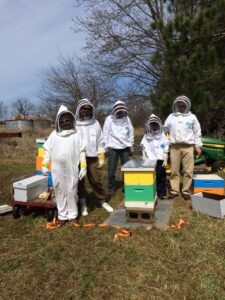I’m lying. To me, bees are anything but taxing. But, having written a couple big checks this tax season, I’m trying to find some humor in the situation with a play on words.
Speaking of playing, we played with bees this weekend, when we helped some new beekeepers install their nucs. As their mentor, I thought I was quite clear about when they should get back into the hives. Bees communicate with scent, so you don’t want to dilute that too much with too frequent openings.

Welcome to beekeeping A, M and C! What you can’t tell through the veils is that it is a Grandpa and two grandchildren. I’m delighted to be involved with a multi-generational effort. I’m second from left; Hubby Marshall is on the right. We have two deeps at this point because the top boxes house a jar feeder over the hole in the inner cover.
The guidance I provided was that they check the internal feeders (in these two cases) within 2-3 days at the earliest (and keep them filled), and check for eggs to ensure the queen is laying about 5 days after install.
I had to laugh when both groups of newbees called me 24 hours after install to tell me what they’d found. Yep, they were in the hives, checking it all out—the very next day. Yep, you could say they’re very excited about bee-coming beekeepers!
I am very excited for them, and very excited to be starting my eighth year. I sat near a survivor hive recently for nearly an hour—mesmerized by their bringing in pollen and their ignoring of me. I write for a living, yet words fail me when it comes to describing how magical this insect is, and how smitten with their fuzzy busyness I am…not to mention how appreciative I am of the species responsible for blueberry muffins and apple cider.
We are getting package bees on 4/29, and I’ll be sharing progress, reminders and milestones so others can gain some perspective. If you already have packages installed, my insights can be found in older entries of this blog from about a year ago. I did frequent posts last spring for what you should look for and what you should do.
For those of you with nucs installed – please keep providing them feed. Ours aren’t taking it; they seem to prefer the natural stuff spring is bringing forth. But, we could get some rainy days, so the option of 1:1 sugar syrup I feel is always a good idea.
Another thing I suggest you do at this time is check within a week of install to ensure the queen is laying properly—one egg / cell.
Multiple eggs per cell likely means you have a laying worker – a problem.
No eggs means either you can’t find them (a real possibility for newbees and we older folks!), or that the queen isn’t there, isn’t properly fertilized, or is possibly recovering from travel. If you can’t find eggs, check again a few days later for larva (easier to see—the small white worms curled in the bottom of a cell.) If you don’t find those within 10 days of install, you likely have a queen problem.
As always, the above are just my thoughts and opinions. Good luck with your bees, and your taxes. I’m available by email or cell for questions if I can help with the former. I offer no insights on dealing with the latter!
